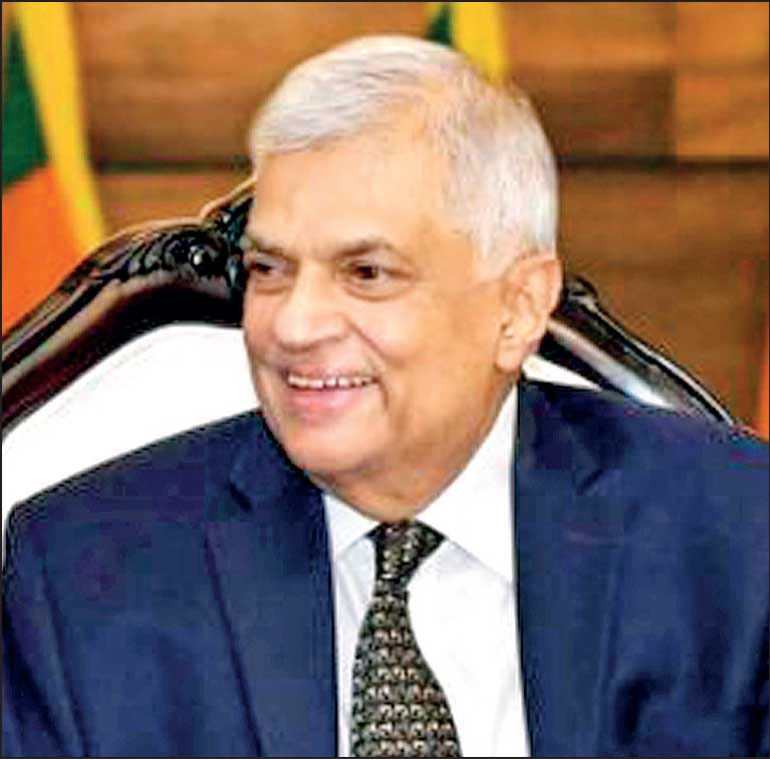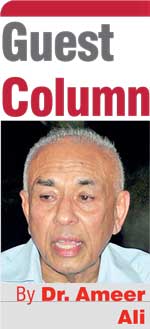Tuesday Nov 18, 2025
Tuesday Nov 18, 2025
Tuesday, 7 March 2023 00:17 - - {{hitsCtrl.values.hits}}

With IMF he is trying to repair the economy and with the old mob he is trying to protect the system by smoothening its rough edges
 While President Ranil Wickremesinghe (RW), his cabinet of ministers and the Governor of CBSL are awaiting anxiously to the early release of IMF’s $ 2.9 billion Extended Funding Facility (EFF), in spite of China’s reluctance to offer financing assurance on Sri Lanka’s debt, the question remains whether that facility and in consequence of it an expected inflow of another $ 5 billion or so from the World Bank, Asian Development Bank and other sources would be sufficient to cure the country’s systemic malaise.
While President Ranil Wickremesinghe (RW), his cabinet of ministers and the Governor of CBSL are awaiting anxiously to the early release of IMF’s $ 2.9 billion Extended Funding Facility (EFF), in spite of China’s reluctance to offer financing assurance on Sri Lanka’s debt, the question remains whether that facility and in consequence of it an expected inflow of another $ 5 billion or so from the World Bank, Asian Development Bank and other sources would be sufficient to cure the country’s systemic malaise.
The answer to this question depends on whether one looks at the economic crisis in isolation from or as part of a crippling systemic crisis that reached its apogee during Gotabaya Rajapaksa’s presidency. Besides, IMF assistance also carries geopolitical implications in the sense that its funds are used as leverage to win support from the receivers for US’ struggle for world dominance.
RW, his government and all opposition parties or coalitions, except NPP and its partner JVP, seem to be of the view that IMF’s prescription is a panacea for the country’s economic and financial crises. The only source of quarrel among them is over the harshness of IMF’s conditionalities such as higher taxes and tariffs, cutting down public expenditure and privatising state-owned enterprises, parts of which measures had been incorporated already in RW’s 2023 budget. Based on the IMF induced confidence RW is already bragging about a 25-year transformation of Sri Lanka’s economy into a high-tech export-oriented miracle. All opposition groups minus NPP also seem to be in cahoots with RW’s phantasmagoria by failing to respond to his challenge for a better alternative than the IMF agenda. NPP/JVP on the other hand identifies the economic crisis not in isolation but as part of a more fundamental systemic crisis.
At the outset, credit must be given to the Aragalaya youth for identifying for the first time (some may argue that the leftists of 1950s and 60s also said the same) that the problem is not in the economy as such, but in the super structure of a socio-political system and its culture, cemented by the pernicious ideology of Sinhala Buddhist majoritarianism. In that perspective, economy is a victim of the system. The Aragalaya youth detected further that it was the social license the system granted to its managers, functionaries and apparatchiks which ultimately ruined the economy and bankrupted the Treasury. From that perspective therefore, replenishing the Treasury with financial injections from IMF and other agencies may provide temporary palliative but they would not be the panacea for the systemic crisis.
Hence, the youth’s uncompromising demand for (a) system change and (b) smaller and more capable legislature. There is therefore, a dichotomy of approach in tackling the nation’s “polycrisis”, a term popularised by the English historian John Adam Tooze. It is a pity that reputable economists, political scientists, experienced central bankers and even intellectual commentators and analysts seem to have fallen prey to the textbook approach to study economy by discarding the relevance of real problems and considering them as irritating variables that spoil the theoretical rigour of their analyses. This is a phenomenon not confined to Sri Lankan experts alone, but rather endemic to many analysts in the neo-liberal academic world. It is this narrow focus that failed to predict some of the cataclysmic events like for example, the OPEC crisis in 1970s, 2007-9 Global Financial Crisis and 2021 COVID-19 pandemic, which caused untold agony and “deaths of despair” even in developed parts of the world.
The Sri Lankan case however, is unique in the sense that its economy is the victim of a pernicious ideology that, in the name of a numerically strong community, seeks to claim total ownership of the country at the expense of other ethnic and religious minorities. This is an ideology that is totally alien to that community’s original beliefs and cultural ethos. Yet, there seems to be a strange unwillingness within the intellectual community to understand the link between this ideology and the system it created on the one hand and the economic crisis on the other.
From the time of the disenfranchisement of Indian Tamils in 1948, right through decades of organised violence including a war against indigenous Tamils, and until after 2009 when systematic violence was unleashed against the Muslim minority, the majoritarian ideology had ignored its hidden cost to the economy. That ideology manipulated the country’s democracy in such a way that it not only and always produced a government, which vowed to protect and promote Sinhala Buddhist domination, but also created an economic system that benefitted that majority at the expense of other minorities.
This narrow focus by creating a disconnect between the majority and minorities deprived the economy of enormous amount of financial, intellectual, entrepreneurial and social capital that are essential building blocks for sustainable growth and development. What is more diabolical in the system is the space it created for corruption and illicit accumulation of wealth by a few at the expense of many with no accountability to any authority. Every government institution, including the Central Bank and the judiciary were subverted to serve the system. How can foreign funds alone correct this decadent system? No doubt, the system boasted of producing periodic bouts of growth but they could not be sustained for long. Projects were funded with borrowed money simply to enhance the personal prestige and popularity of system managers. The Mattala Airport, the Lotus Tower, Hambantota cricket stadium, the artificial beach at Colombo Port City and thousands of kilometres of unprofitable expressways and highways are shining examples of this waste. How much money was spent on them and where did that money come from are all still a mystery. There was absolutely no accountability.
Even when the personal secretary of a Prime Minister was caught for misusing the PM’s bank card to withdraw money for the secretary’s use that culprit was magnanimously pardoned and not taken to the court, perhaps in fear of that offender spilling more beans about the PM’s own surreptitious wealth. In such an environment of misgovernance and misappropriation of public funds should it be a surprise that the economy reached its point of nadir and reached a state of historic crisis?
This then was the situation when the youth rose in revolt with the demand for systemic change. When they proved that their Aragalaya was not another demonstration of romantic revolutionary politics, but an ongoing struggle until success was achieved, guardians of the system panicked. Out of that panic emerged a new autocrat, President RW, who is also the Commander-in-Chief of the tri-forces and manager of the country’s finance.
RW is no doubt the chief architect of the IMF experiment, which he advocated from the days when he was in opposition. He has now got the power bestowed upon him by a constitution produced by the system, and carries support not only from IMF and its shareholders but also, and more importantly, from the ones who bankrupted the economy in the first place and shifted the onus of repairing it to RW, by making him the new chief. With IMF he is trying to repair twhe economy and with the old mob he is trying to protect the system by smoothening its rough edges. Hence, he has separated the economy from the system and vows to develop it within the majoritarian paradigm. Unfortunately, the opposition minus NPP seems to have no alternative but to go along with him.
But there is one question left unanswered in the IMF model of reparation. What is the role of ordinary people in the implementation of IMF agenda other than to pay taxes and tightening their belts? Where are the incentives for them to get involved in not just repairing the damage but in producing an economic surplus that would be the ultimate solution to the economic crisis? To provide those incentives one has to go beyond the IMF agenda and remove the system that had been gnawing the economy for decades until it reached the point of bankruptcy.
As the IMF palliative starts increasing the pain before producing any gain, public dissent is bound to worsen. As one observer put it RW is caught “between the repressive hammer and anarchic anvil”. Will the youth resume its Aragalaya and join hands with NPP to hasten the change they demanded?
(The writer is attached to Murdoch Business School, Murdoch University, Western Australia.)